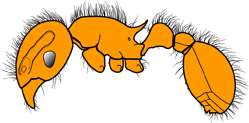 Pacific Invasive Ants
Pacific Invasive Ants
Non-native ant species are invading terrestrial ecosystems across the globe. Although many of these invaders can go unnoticed, others pose significant risks to local biological diversity, agricultural production, and public health. They can disrupt critical ecological relationships among native species. They can protect crop pests from their natural enemies. They can can inflict painful stings with venom and acid.
The Pacific Island region has received more ant invasions than any other region in the world. Invasive ants such as Wasmannia auropunctata, Anoplolepis gracilipes and Linepithema humile have caused wide scale destruction to many islands in Polynesia, Melanesia and Micronesia. The most notorious invasive ant of all, Solenopsis invicta, has established colonies in Asia and Australia, and is now poised to invade the islands of the Pacific.
Early detection is critical for stopping the spread of invasive ants to the shores of more nations. Once invasive ants establish a new population they are nearly impossible to eradicate, and even the most well funded management plans usually result in failure. Therefore, surveillance programs at high risk sites, such as ports of entry, are the most cost-effective means to keep invasive ants from damaging the natural resources and economies of Pacific Islands.
PIAkey is designed to assist users identify the most common and dangerous invasive ant species threatening the ecosystems, economies and people of the Pacific Island region.
